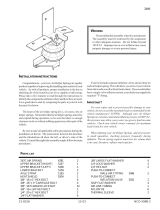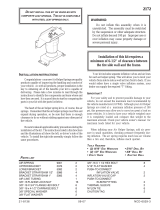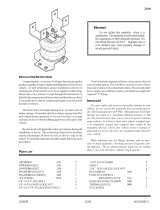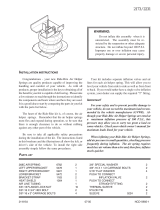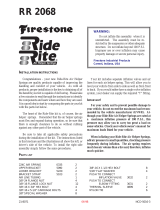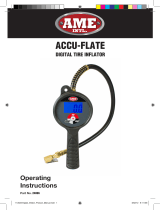Page is loading ...

For maximum effectiveness and safety,
please read these instructions completely
before proceeding with installation.
Failure to read these instructions can result in an
incorrect installation.
MN-228 • (071108) • ECR 7136
INSTALLATION GUIDE
Cover
illustration
may not depict
actual kit.
Kit 57217
LoadLIFTER
5000


MN-381
1
LoadLifter 5000
TABLE OF CONTENTS
Introduction ............................................. 2
Important Safety Notice ................................................2
Notation Explanation ...................................................2
Installation Diagram ...................................... 3
Installing the LoadLifter 5000 System ....................... 4
Installing the Air Springs ................................................4
Dual Air Line Routing. . . . . . . . . . . . . . . . . . . . . . . . . . . . . . . . . . . . . . . . . . . . . . . . . . . 6
Checking For Leaks. . . . . . . . . . . . . . . . . . . . . . . . . . . . . . . . . . . . . . . . . . . . . . . . . . . . 7
Fixing Leaks .........................................................7
Before Operating ........................................ 9
Installation Checklist ...................................................9
Post-Installation Checklist ...............................................9
Product Use, Maintenance and Servicing ...................10
Minimum and Maximum Pressure .........................................10
Maintenance Guidelines ................................................10
Troubleshooting Guide .................................................10
Frequently Asked Questions .............................................11
Tuning the Air Pressure .................................................11
Guidelines for Adding Air ................................................12
Choosing the Right On-Board Air Compressor System .......13
Warranty and Returns Policy ..............................14
Replacement Information .................................15
Contact Information ......................................15

MN-381
2
LoadLifter 5000
Introduction
The purpose of this publication is to assist with the installation, maintenance and
troubleshooting of the LoadLifter 5000 air spring kit. LoadLifter 5000 utilizes sturdy, reinforced,
commercial grade single or double, depending on the kit, convolute bellows. The bellows are
manufactured like a tire with layers of rubber and cords that control growth. LoadLifter 5000
kits are recommended for most 3/4 and 1 ton pickups and SUVs with leaf springs and provide
up to 5,000 lbs. of oad leveling support with air adjustability from 5-100 PSI. The kits are
also used in motor home rear kits and some motor home fronts where leaf spring are used.
It is important to read and understand the entire installation guide before beginning installation
or performing any maintenance, service or repair. The information here includes a hardware
list, tool list, step-by-step installation information, maintenance guidelines and operating tips.
Air Lift Company reserves the right to make changes and improvements to its products and
publications at any time. For the latest version of this manual, contact Air Lift Company at
(800) 248-0892 or visit our website at www.airliftcompany.com.
IMPORTANT SAFETY NOTICE
The installation of this kit does not alter the Gross Vehicle Weight Rating (GVWR) or payload
of the vehicle. Check your vehicle’s owner’s manual and do not exceed the maximum load
listed for your vehicle.
Gross Vehicle Weight Rating: The maximum allowable weight of the fully loaded vehicle
(including passengers and cargo). This number — along with other weight limits, as well
as tire, rim size and ination pressure data — is shown on the vehicle’s Safety Compliance
Certication Label.
Payload: The combined, maximum allowable weight of cargo and passengers that the truck
is designed to carry. Payload is GVWR minus the Base Curb Weight.
NOTATION EXPLANATION
Hazard notations appear in various locations in this publication. Information which is
highlighted by one of these notations must be observed to help minimize risk of personal
injury or possible improper installation which may render the vehicle unsafe. Notes are used
to help emphasize areas of procedural importance and provide helpful suggestions. The
following denitions explain the use of these notations as they appear throughout this guide.
INDICATES IMMEDIATE HAZARDS WHICH WILL RESULT IN SEVERE PERSONAL
INJURY OR DEATH.
INDICATES HAZARDS OR UNSAFE PRACTICES WHICH COULD RESULT IN SEVERE
PERSONAL INJURY OR DEATH.
INDICATES HAZARDS OR UNSAFE PRACTICES WHICH COULD RESULT IN DAMAGE
TO THE MACHINE OR MINOR PERSONAL INJURY.
Indicates a procedure, practice or hint which is important to highlight.
DANGER
NOTE
WARNING
CAUTION

MN-381
3
LoadLifter 5000
Installation Diagram
g. 1
Missing or damaged parts? Call Air Lift customer
service at (800) 248-0892 for a replacement part.
STOP!

MN-381
4
LoadLifter 5000
Installing the LoadLifter 5000 System
DANGER
DO NOT INFLATE BELLOWS WHEN IT IS UNRESTRICTED OR UN-INSTALLED.
BELLOWS MUST BE CONTAINED BY SUSPENSION OR OTHER ADEQUATE
STRUCTURE. DO NOT INFLATE BEYOND 100 PSI. IMPROPER USE OR OVER
INFLATION MAY CAUSE ASSEMBLY TO BURST CAUSING PROPERTY DAMAGE
OR SEVERE PERSONAL INJURY.
NEVER EXCEED THE MANUFACTURER’S MAXIMUM GROSS VEHICLE WEIGHT
RATING.
DO NOT INSTALL THE AIR SPRING AS THE PRIMARY SUSPENSION SPRING.
THIS PRODUCT IS INTENDED FOR LOAD ASSIST ONLY.
IMPORTANT: Your vehicle may be equipped with a rear brake proportioning valve. ANY
type of load assist suspension product could affect brake performance. We recommend that
you check with your dealer before installing this type of product. If your vehicle DOES NOT
have a proportioning valve or is equipped with an anti-lock type brake system, installation of
a load assist product will have NO EFFECT ON THE BRAKE SYSTEM PERFORMANCE.
NORMAL RIDE HEIGHT: Normal ride height is dened as the measured distance from
the bottom edge of the fenderwell to the center point of the wheel with the vehicle in “as
delivered condition” (without camper, tool boxes, unusual load, etc.). This measurements
should be recorded for later reference. All AIR LIFT kits are designed to be installed and
operate at normal ride height.
INSTALLING THE AIR SPRINGS
1. Jack up rear of vehicle or raise on hoist.
Remove rearwheels and support frame with safety stands.
2. Lower axle or raise frame an additional 2 - 3 inches to provide clearance when positioning
air spring assembly.
If the vehicle is equipped with a factory sway bar, it will be necessary to set the lower axle
clamp in place before lowering axle (Figure 1).
3. Remove the jounce bumper and bracket from the frame rails (may be bolted or riveted).
4. Install the air tting into the bellows. The threads are precoated with sealant. Install nger
tight plus two turns. Use an open end wrench being careful to tighten on the metal hex
nut only. Do not over tighten.
5. A spacer is required so that the lower bracket sits level on the axle housing/jounce bumper
pad. Insert 3/8-16x3/4” HHCS bolt through lower bracket and secure with 3/8” lock nut
(Figure 1). The spacer should sit inboard of the jounce bumper pad (Figure 2).
6. Put the 3/8-16x7” carriage bolts into the rectangle holes in the lower bracket. Attach the
bellows onto the upper and lower brackets using the round holes with the 3/8”-16x1”
mounting bolts, at washers, and lock washers. There are right and left hand units
(marked). Tighten to 15-20 ft-lbs. (Figure 1).
7. Place the assembly on the axle housing, guide the carriage bolts through the axle clamp
and align so that the bellows follows the natural arc of the suspension travel. Attach lower
bracket to axle housing loosely using axle clamp, at washers and locknuts (Figures 1,
4).
NOTE
NOTE
NOTE

MN-381
5
LoadLifter 5000
DO NOT DRILL HOLES INTO THE FRAME UNTIL ANY AND ALL HYDRAULIC, FUEL,
OR ELECTRICAL LINES HAVE BEEN MOVED OR SHIELDED.
8. Raise the axle or lower the frame until the axle is in the normal ride height (no load)
position. Install the upper bracket. You may be able to use the one or both of the existing
holes from the jounce bumper bracket. If not, use the holes on each end of the upper
bracket as a template to mark and drill two 3/8” diameter holes in the bottom of the
frame rail (Figure 3). The holes in the upper bracket are slotted for adjustment. Install
the 3/8-16x1.5” HEX HEAD bolt in the REAR hole, at washers and locknut. Install the
3/8-16x1.5” CARRIAGE bolt in the FRONT hole, at washer and locknut. LEAVE LOOSE
AT THIS TIME.
CAUTION
g. 2
g. 3
g. 4

MN-381
6
LoadLifter 5000
9. With the upper bracket in this position, and using the bracket as a template, mark and drill
the 3/8” hole on the OUTBOARD side of the frame rail though the upper bracket. Install
the 3/8-16x1.5” HHCS bolt, at washer and locknut and tighten to 20 ft.lbs. Tighten the
two bolts previously installed (Figure 1).
10. Again, check the alignment of the assembly and tighten the lower mount down. Tighten
to 20 ft-lbs.
DUAL AIR LINE ROUTING
A. Select a location for the ination valves in the rear bumper area or rocker panel ange
insuring that each valve will be protected and accessible with an air hose (Figure 5).
g. 5
B. Use a standard tube cutter, a razor blade, or very sharp knife to cut the air line assembly
into two equal parts. A clean square cut will ensure against leaks. Drill 5/16” hole for
ination valves and mount as illustrated. Rubber washer on outside is for weather seal
(Figure 6).
CAUTION
g. 6
LEAVE SUFFICIENT AIR LINE SLACK TO PREVENT ANY STRAIN ON VALVE STEM
DURING NORMAL AXLE MOTIONS.
C. Route air line from ination valve location along frame rail to bellows. Route the air line

MN-381
7
LoadLifter 5000
so that it will be protected from the direct heat from the mufer or tailpipe and kept away
from sharp edges. The air line should not be bent or curved sharply. (Figure 5). Attach
air line to chassis with the provided plastic straps.
TO PREVENT AIR LINE FROM MELTING, KEEP IT AT LEAST TWELVE INCHES FROM
EXHAUST SYSTEM. USE THERMAL SLEEVE ON EXHAUST SIDE (FIGURE 1).
D. Cut off excess air line squarely and install into the tting. This is a self locking tting. Push
and slightly turn the cut end of the air line into the tting as far as it will go (approximately
9/16”). You will hear/feel a denite “click” when the air line is seated. The air line is now
installed.
E. Repeat process for other side.
11. Installation of this kit requires an exhaust heat shield (Figure 7). The shield is attached
with the stainless steel clamps to the exhaust pipe, with the anges being bent inward.
Shield may be trimmed or bent to attain component clearance. Bend tabs to provide 1/2”
dead air space between exhaust pipes and heat shield and maximum clearance with
bellows.
12. Remount rear wheels. Inate air springs to 40 p.s.i. air pressure. Test for air leaks by
applying a soapy solution to all valve cores, ttings and connections.
13. This now completes the installation. Before proceeding, check once again to be sure
you have sufcient clearance around the bellows at maximum inated diameter of 7.0”.
14. Lower vehicle to the ground and deate the air springs until the vehicle sits level when
viewed from the side.
CHECKING FOR LEAKS
1. Inate the air spring to 60 p.s.i.
2. Spray all connections and the ination valves with a solution of 1/5 liquid dish soap
and 4/5 water to check for leaks. You should be able to spot leaks easily by looking for
bubbles in the soapy water.
3. After the test, deate the springs to the minimum pressure required to restore the Normal
Ride Height, but not less than 5 p.s.i.
Check the air pressure again after 24 hours. A 2 to 4 p.s.i. loss after initial installation is
normal. Retest for leaks if the loss is more than 5 lbs.
FIXING LEAKS
1. If there is a problem with the swivel tting, then:
CAUTION
g. 7
NOTE

MN-381
8
LoadLifter 5000
a. Check the air line connection by deating the spring and removing the line by pulling the
collar against the tting and pulling rmly on the air line. Trim 1” off the end of the air
line. Be sure the cut is clean and square. Reinsert the air line into the push-to-connect
tting.
b. Check the threaded connection by tightening the swivel tting another 1/2 turn. If it
still leaks, deate the air spring, remove the tting, and re-coat the threads with thread
sealant. Reinstall by hand tightening as much as possible, then use a wrench for an
additional two turns.
2. If there is a problem with the ination valve, then:
a. Check the valve core by tightening it with a valve core tool.
b. Check the air line connection by removing the air line from the barbed type tting.
DO NOT CUT IT OFF. AS THIS WILL USUALLY NICK THE BARB AND RENDER THE
FITTING USELESS. CUT AIR LINE OFF A FEW INCHES IN FRONT OF THE FITTING
AND USE A PAIR OF PLIERS OR VISE-GRIPS TO PULL/TWIST THE AIR LINE OFF THE
FITTING.
3. If the preceding steps have not resolved the problem, call Air Lift Technical Service at
1-800-248-0892 for assistance.
CAUTION

MN-381
9
LoadLifter 5000
Overnight leak down test — Recheck air pressure after the vehicle has been used for
24 hours. If the pressure has dropped more than 5 PSI, then there is a leak that must
be xed. Either x the leak yourself or return to the installer for service.
Air pressure requirements — Regardless of load, the air pressure should always be
adjusted to maintain ride height at all times.
Thirty day or 500 mile test —Recheck the air spring system after 30 days or 500 miles,
whichever comes first. If any part shows signs of rubbing or abrasion, the source should be
identified and moved, if possible. If it is not possible to relocate the cause of the abrasion,
the air spring may need to be remounted. If professionally installed, the installer should
be consulted. Check all fasteners for tightness.
POST-INSTALLATION CHECKLIST
Clearance test — Inflate the air springs to 60 PSI and ensure there is at least ½” clearance
around each bellow, away from anything that might rub against them. Be sure to check
the tire, brake drum, frame, shock absorbers and brake cables.
Leak test before road test — Inflate the air springs to 60 PSI, check all connections for
leaks with a soapy water solution. See page 12 for tips on how to spot leaks. All leaks
must be eliminated before the vehicle is road tested.
Heat test — Be sure there is sufficient clearance from any heat sources — at least 6”
for air springs and air lines. If a heat shield was included in the kit, install it. If there is no
heat shield, but one is required, call (800) 248-0892.
Fastener test — Recheck all bolts for proper torque. Axle clamp bar carriage bolt lock
nuts should be torqued to 16 ft/lbs. Re-torque after 100 miles.
Road test — The vehicle should be road tested after the preceding tests. Inflate the air
springs to 25 PSI (50 PSI if the vehicle is loaded). Drive the vehicle 10 miles and recheck
for clearance, loose fasteners and air leaks.
Operating instructions — If professionally installed, the installer should review the Product
Use, Maintenance and Servicing section on page 14 with the owner. Be sure to provide
the owner with all of the paperwork which came with the kit.
Technician’s Signature ________________________
Date ______________
Before Operating
INSTALLATION CHECKLIST (To be completed by installer)

MN-381
10
LoadLifter 5000
MAINTENANCE GUIDELINES
By following the steps below, vehicle owners will obtain the longest life and best results
from their air springs.
1. Check the air pressure weekly.
2. Always maintain normal ride height. Never inate beyond 100 PSI.
3. If you develop an air leak in the system, use a soapy water solution (1/5 liquid dish
soap and 4/5 water) to check all air line connections and the ination valve core before
deating and removing the air spring.
FOR YOUR SAFETY AND TO PREVENT POSSIBLE DAMAGE TO YOUR VEHICLE, DO
NOT EXCEED MAXIMUM GROSS VEHICLE WEIGHT RATING (GVWR), AS INDICATED
BY THE VEHICLE MANUFACTURER. ALTHOUGH YOUR AIR SPRINGS ARE RATED AT
A MAXIMUM INFLATION PRESSURE OF 100 P.S.I., THE AIR PRESSURE ACTUALLY
NEEDED IS DEPENDANT ON YOUR LOAD AND GVWR.
4. Loaded vehicles require at least 25 PSI or more. A “loaded vehicle” refers to a vehicle
with a heavy bed load, a trailer, or both. As discussed above, never exceed GVWR,
regardless of air spring, air pressure, or other load assist. The springs in this kit will support
approximately 40 lbs. of load (combined on both springs) for each 1 PSI of pressure.
The required air pressure will vary depending on the state of the original suspension.
Operating the vehicle below the minimum air spring pressure will void the Air Lift warranty.
5. When increasing load, always adjust the air pressure to maintain the normal ride height.
Increase or decrease pressure from the system as necessary to attain normal ride height
for optimal ride and handling. Remember that loads carried behind the axle (including
tongue loads) require more leveling force (pressure) than those carried directly over the
axle.
6. Always add air to springs in small quantities, checking the pressure frequently.
7. Should it become necessary to raise the vehicle by the frame, make sure the system is at
minimum pressure (5 PSI) to reduce the tension on the suspension/brake components.
Use of on board leveling systems do not require deation or disconnection.
8. Periodically check the air spring system fasteners for tightness. Also, check the air springs
for any signs of rubbing. Realign if necessary.
9. On occasion, give the air springs a hard spray with a garden hose in order to remove
mud, sand, gravel or other abrasive debris.
TROUBLESHOOTING GUIDE
1. Leak test the air line connections, the threaded connection into the air spring, and all
ttings in the control system.
2. Inspect the air lines to be sure none are pinched. Tie straps may be too tight. Loosen or
replace the strap and replace leaking components.
3. Inspect the air line for holes and cracks. Replace as needed.
NOTE
CAUTION
Product Use, Maintenance and Servicing
5 PSI
100 PSI
FAILURE TO MAINTAIN CORRECT MINIMUM PRESSURE (OR PRESSURE
PROPORTIONAL TO LOAD), BOTTOMING OUT, OVER-EXTENSION OR RUBBING
AGAINST ANOTHER COMPONENT WILL VOID THE WARRANTY.
Maximum Air PressureMinimum Pressure

MN-381
11
LoadLifter 5000
4. Look for a kink or fold in the air line. Reroute as needed.
If the preceding steps do not solve the problem, it is possibly caused by a failed air spring — either
a factory defect or an operating problem. Please call Air Lift at (800) 248-0892 for assistance.
FREQUENTLY ASKED QUESTIONS
Q. Will installing air springs increase the weight ratings of a vehicle?
No. Adding air springs will not change the weight ratings (GAWR, GCWR and/or GVWR)
of a vehicle. Exceeding the GVWR is dangerous and voids the Air Lift warranty.
Q. Is it necessary to keep air in the air springs at all times and how much pressure
will they need?
The minimum air pressure should be maintained at all times. The minimum air pressure
keeps the air spring in shape, ensuring that it will move throughout its travel without
rubbing or wearing on itself.
Q. Is it necessary to add a compressor system to the air springs?
No. Air pressure can be adjusted with any type of compressor as long as it can produce
sufcient pressure to service the springs. Even a bicycle tire pump can be used, but it’s
a lot of work.
Q. How long should air springs last?
If the air springs are properly installed and maintained they can last indenitely.
Q. Will raising the vehicle on a hoist for service work damage the air springs?
No. The vehicle can be lifted on a hoist for short-term service work such as tire rotation
or oil changes. However, if the vehicle will be on the hoist for a prolonged period of time,
support the axle with jack stands in order to take the tension off of the air springs.
TUNING THE AIR PRESSURE
Pressure determination comes down to three things — level vehicle, ride comfort, and
stability.
1. Level vehicle
If the vehicle’s headlights are shining into the trees or the vehicle is leaning to one side,
then it is not level (g. 2.1). Raise the air pressure to correct either of these problems
and level the vehicle.
2. Ride comfort
If the vehicle has a rough or harsh ride it may be due to either too much pressure or not
enough (g. 2.2). Try different pressures to determine the best ride comfort.
3. Stability
Stability translates into safety and should be the priority, meaning the driver may need
to sacrice a perfectly level and comfortable ride. Stability issues include roll control,
bounce, dive during braking and sponginess (g. 2.3). Tuning out these problems usually
requires an increase in pressure.
g. 2.1
Bad headlight aim
Sway and
body roll
g. 2.3
Rough ride
g. 2.2

MN-381
12
LoadLifter 5000
GUIDELINES FOR ADDING AIR
1. Start with the vehicle level or slightly above.
2. When in doubt, always add air.
3. If the front of the vehicle dives while braking, increase the pressure in the front air bags, if
equipped.
4. If it is ever suspected that the air bags have bottomed out, increase the pressure (g. 2.4).
5. Adjust the pressure up and down to nd the best ride.
6. If the vehicle rocks and rolls, adjust the air pressure to reduce movement.
7. It may be necessary to maintain different pressures on each side of the vehicle. Loads
such as water, fuel, and appliances will cause the vehicle to be heavier on one side (g.
2.5). As much as a 50 PSI difference is not uncommon.
g. 2.4
Bottoming out
g. 2.5
Unlevel
Level

MN-381
13
LoadLifter 5000
Choosing the Right On-Board Air Compressor System
Add an on-board air compressor sytem to inate and deate your air
springs with the touch of a button — from inside or outside of the
vehicle.
• For convenient, on-the-go control of your air springs, add an Air Lift on-board air
compressor system.
• Air Lift on-board air compressor systems eliminate the search for gas stations that have
a working compressor, saving you time, energy and money.
• All systems include a compressor, controller and all parts needed for easy installation.
1. Choose single or dual path ination (see
illustrations at right)
2. Choose wireless or analog control
• Wireless: Control your air springs from
inside or outside the vehicle. Easiest
installation - no wires to the cab.
• Analog: In-cab control of your air springs.
Economically priced.
3. Choose heavy or standard duty compressor
• Standard duty: A standard duty compressor
will work well for most customers who use
their system on an intermittent basis.
• Heavy duty: For daily use, consider
the heavy duty compressor - it inates
faster and more quietly than the standard
compressor.
Visit www.airliftcompany.com for more detailed
info on compressor systems.
Single path systems Two springs will
inate at the same time. Good for loads
that are evenly distributed from left-to-
right or front-to-back.
Dual path systems Air springs are
controlled separately to allow for different
air pressure from side-to-side. Perfect for
uneven or top-heavy loads.
WIRELESS
DUAL PATH
SINGLE PATH
ANALOG
DEFLATE
RIGHT
DEFLATE
LEFT
INFLATE
BOTH
WirelessAIR
TM
WirelessONE
TM
LoadCONTROLLER
TM
Dual
Single
LoadCONTROLLER
TM
DEFLATE
BOTH
INFLATE
BOTH
• Easy installation
• Includes heavy
duty compressor
Compact,
economically priced
control.
Compact,
economically priced
control.
• Easy installation
• Includes standard
duty compressor
P/N Standard Duty Compressor
25850; P/N Heavy Duty mpressor 25854
P/N Standard Duty Compressor
25852; P/N Heavy Duty Compressor 25856
P/N 25870
P/N 72000

MN-381
14
LoadLifter 5000
Air Lift 1000 ........................Lifetime Limited
RideControl ........................Lifetime Limited
LoadLifter 5000*.................Lifetime Limited
LoadLifter 5000 Ultimate ... Lifetime Limited
SlamAir ...............................Lifetime Limited
AirCell .................................Lifetime Limited
Air Lift Performance** ..........1 Year Limited
LoadController/Single ..........2 Year Limited
LoadController/Dual .............2 Year Limited
Load Controller (I) ................2 Year Limited
Load Controller (II) ...............2 Year Limited
SmartAir ................................2 Year Limited
Wireless AIR..........................2 Year Limited
WirelessONE .........................2 Year Limited
Other Accessories ................ 2 Year Limited
*formerly SuperDuty
**formerly LifeSTYLE & Performance, EasyStreet
Air Lift Company warrants its products, for the time periods listed below, to the original
retail purchaser against manufacturing defects when used on catalog-listed applications on
cars, vans, light trucks and motorhomes under normal operating conditions for as long as
Air Lift manufactures the product. The warranty does not apply to products that have been
improperly applied, improperly installed, used in racing or off-road applications, used for
commercial purposes, or which have not been maintained in accordance with installation
instructions furnished with all products. The consumer will be responsible for removing
(labor charges) the defective product from the vehicle and returning it, transportation costs
prepaid, to the dealer from which it was purchased or to Air Lift Company for verication.
Air Lift will repair or replace, at its option, defective products or components. A minimum
$10.00 shipping and handling charge will apply to all warranty claims. Before returning
any defective product, you must call Air Lift at (800) 248-0892 in the U.S. and Canada
(elsewhere, (517) 322-2144) for a Returned Materials Authorization (RMA) number.
Returns to Air Lift can be sent to: Air Lift Company • 2727 Snow Road • Lansing, MI •
48917.
Product failures resulting from abnormal use or misuse are excluded from this warranty. The
loss of use of the product, loss of time, inconvenience, commercial loss or consequential
damages is not covered. The consumer is responsible for installation/reinstallation (labor
charges) of the product. Air Lift Company reserves the right to change the design of any
product without assuming any obligation to modify any product previously manufactured.
This warranty gives you specific legal rights and you may also have other rights that vary
from state-to-state. Some states do not allow limitations on how long an implied warranty
lasts or allow the exclusion or limitation of incidental or consequential damages. The above
limitation or exclusion may not apply to you. There are no warranties, expressed or implied
including any implied warranties of merchantability and tness, which extend beyond this
warranty period. There are no warranties that extend beyond the description on the face
hereof. Seller disclaims the implied warranty of merchantability. (Dated proof of purchase
required.)
Warranty and Returns Policy

MN-381
15
LoadLifter 5000
Replacement Information
If you need replacement parts, contact the local dealer or call Air Lift customer service at
(800) 248-0892. Most parts are immediately available and can be shipped the same day.
Contact Air Lift Company customer service at (800) 248-0892, rst if:
• Parts are missing from the kit.
• Need technical assistance on installation or operation.
• Broken or defective parts in the kit.
• Wrong parts in the kit.
• Have a warranty claim or question.
Contact the retailer where the kit was purchased:
• If it is necessary to return or exchange the kit for any reason.
• If there is a problem with shipping if shipped from the retailer.
• If there is a problem with the price.
Contact Information
If you have any questions, comments or need technical assistance, contact our customer
service department by calling (800) 248-0892, Monday through Friday. For calls from outside
the USA or Canada, our local number is (517) 322-2144.
For inquiries by mail, our address is PO Box 80167, Lansing, MI 48908-0167. Our shipping
address for returns is 2727 Snow Road, Lansing, MI 48917.
You may also contact us anytime by e-mail at [email protected] or on the web at
www.airliftcompany.com.



Air Lift Company • 2727 Snow Road • Lansing, MI 48917 or PO Box 80167 • Lansing, MI 48908-0167
Toll Free (800) 248-0892 • Local (517) 322-2144 • Fax (517) 322-0240 • www.airliftcompany.com
Thank you for purchasing Air Lift products — the professional installer’s choice!
Printed in
the USA
Need Help?
Contact our customer service department by calling
(800) 248-0892, Monday through Friday. For calls
from outside the USA or Canada, our local number
is (517) 322-2144.
Register your warranty online at
www.airliftcompany.com/warranty
/
